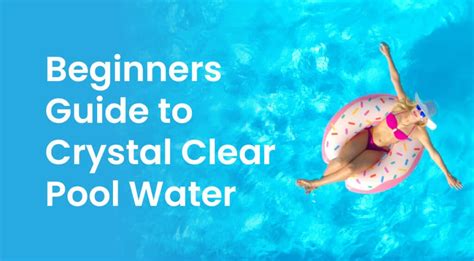The Ultimate Guide to Crystal Clear Pool Water
Dreaming of that perfect, sparkling pool, inviting you to dive in on a hot summer day? Achieving crystal-clear pool water isn't just about aesthetics; it's about maintaining a healthy and safe swimming environment for you and your family. This ultimate guide will walk you through everything you need to know, from understanding basic chemistry to tackling common problems. We'll equip you with the knowledge to keep your pool sparkling all season long.
Understanding Pool Water Chemistry: The Foundation of Clarity
Before diving into cleaning techniques, it's crucial to grasp the basics of pool water chemistry. Maintaining the proper balance of chemicals is the cornerstone of clear, healthy water. The primary elements you need to monitor are:
-
pH: This measures the acidity or alkalinity of your water. The ideal pH range is between 7.2 and 7.8. An imbalance can affect the effectiveness of other chemicals and even irritate swimmers' skin and eyes.
-
Alkalinity: This refers to the water's ability to resist changes in pH. Maintaining proper alkalinity (80-120 ppm) helps keep your pH stable.
-
Sanitizer: This is essential for killing bacteria, algae, and other microorganisms. Chlorine is the most common sanitizer, but others exist, such as bromine. Regular testing and adjustment are vital to ensure effective sanitation.
-
Calcium Hardness: This measures the amount of calcium in your water. While necessary for preventing corrosion, excessively high levels can lead to scaling on pool surfaces.
Regular testing is paramount. Invest in a reliable test kit (either liquid or strip) and test your water at least twice a week, or more frequently during periods of heavy use or inclement weather.
How Often Should You Clean Your Pool?
The frequency of cleaning depends on several factors:
- Pool usage: Heavier use means more frequent cleaning.
- Weather conditions: Rain, leaves, and debris can increase the need for cleaning.
- Pool type: In-ground pools generally require more maintenance than above-ground pools.
As a general rule, aim to:
- Skim the surface daily: This removes leaves, insects, and other debris.
- Brush the walls and floor at least once a week: This dislodges algae and other contaminants.
- Vacuum the pool as needed: This removes settled debris.
- Backwash or clean your filter regularly: Follow the manufacturer's instructions for your specific filter type.
What are the Common Causes of Cloudy Pool Water?
Cloudy water is a telltale sign that something is amiss. Common culprits include:
- Inadequate sanitation: Insufficient chlorine or other sanitizer levels allow algae and bacteria to proliferate, clouding the water.
- Imbalanced pH and alkalinity: These imbalances can hinder the effectiveness of sanitizers and contribute to cloudiness.
- Dirty filter: A clogged filter can't effectively remove debris, leading to cloudy water.
- High levels of phosphates: Phosphates act as a food source for algae, promoting growth and cloudiness. Using a phosphate remover can help.
- Suspended particles: Fine particles, like dirt or dust, can cloud the water.
How Do I Fix Cloudy Pool Water?
Addressing cloudy water requires a systematic approach:
- Test your water: Determine the pH, alkalinity, and sanitizer levels.
- Adjust chemicals: Bring your water chemistry into balance based on test results.
- Clean your filter: Backwash or clean your filter according to the manufacturer's instructions. A thoroughly cleaned filter is often the first step to clear water.
- Shock your pool: This involves adding a large dose of chlorine or other sanitizer to kill bacteria and algae.
- Use a flocculant (clarifier): This chemical helps clump together small particles, making them easier to filter out.
Always follow the instructions on chemical packaging. If the cloudiness persists after these steps, consider consulting a pool professional.
Maintaining Crystal Clear Pool Water: A Weekly Checklist
To prevent problems and maintain sparkling water, establish a weekly routine:
- Test your water: Regularly checking your water chemistry is crucial.
- Skim the surface: Remove floating debris.
- Brush the walls and floor: Prevent algae buildup.
- Vacuum the pool: Remove settled debris.
- Check and clean the filter: Ensure proper filtration.
- Adjust chemicals as needed: Maintain balanced water chemistry.
How Can I Prevent Algae Growth in My Pool?
Algae thrives in warm, sunny conditions and in water with insufficient sanitizer. Prevention is key:
- Maintain proper sanitizer levels: Regularly test and adjust your chlorine or bromine levels.
- Brush the pool regularly: Remove algae before it can establish itself.
- Shock your pool periodically: This helps kill any algae present.
- Clean your filter regularly: A clean filter prevents algae spores from recirculating.
- Consider an algaecide: This can be used as a preventative measure or to treat existing algae.
By following these tips and maintaining a proactive approach, you can enjoy crystal-clear pool water all season long. Remember, regular maintenance and diligent chemical management are your best allies in achieving and preserving that perfect, sparkling oasis.

